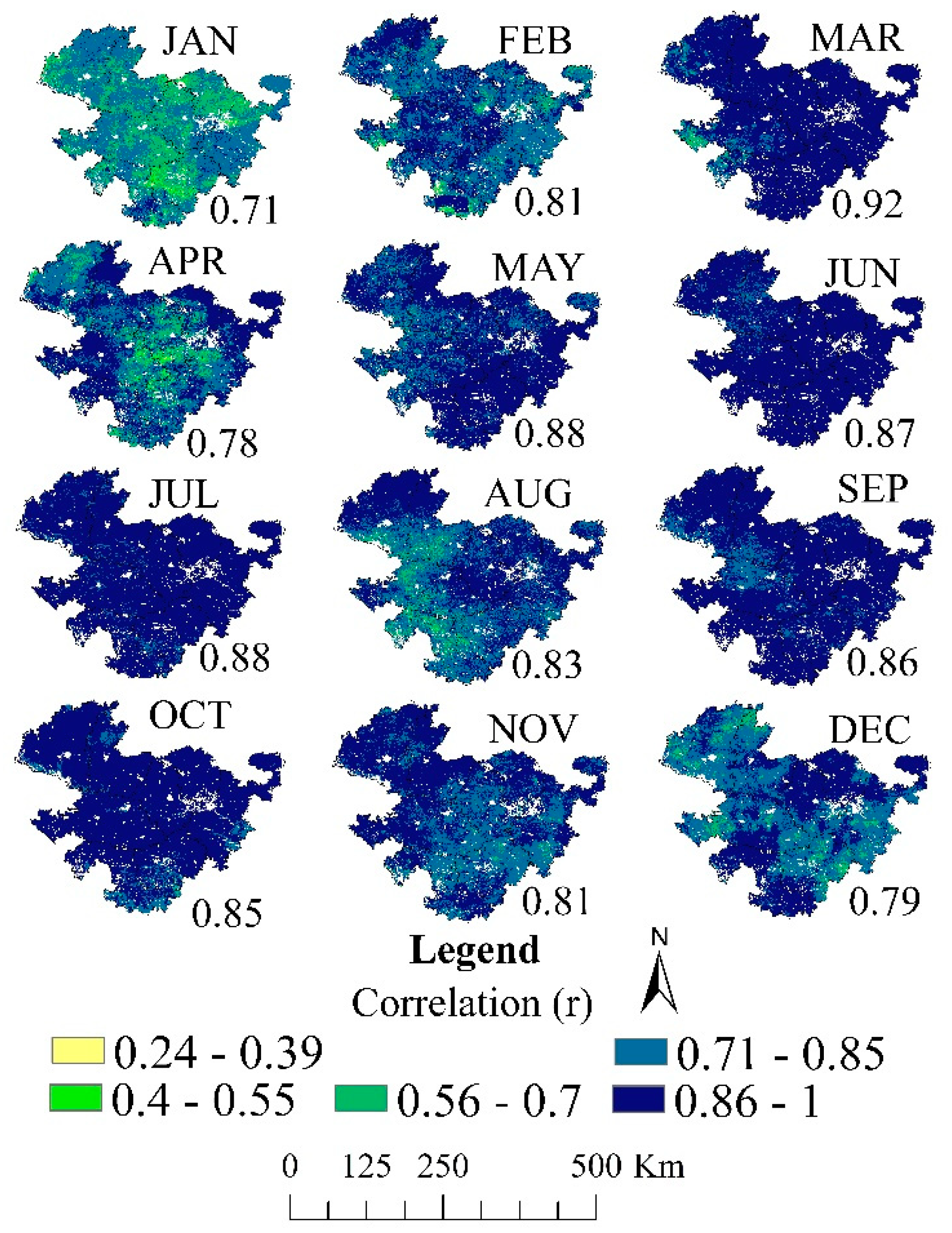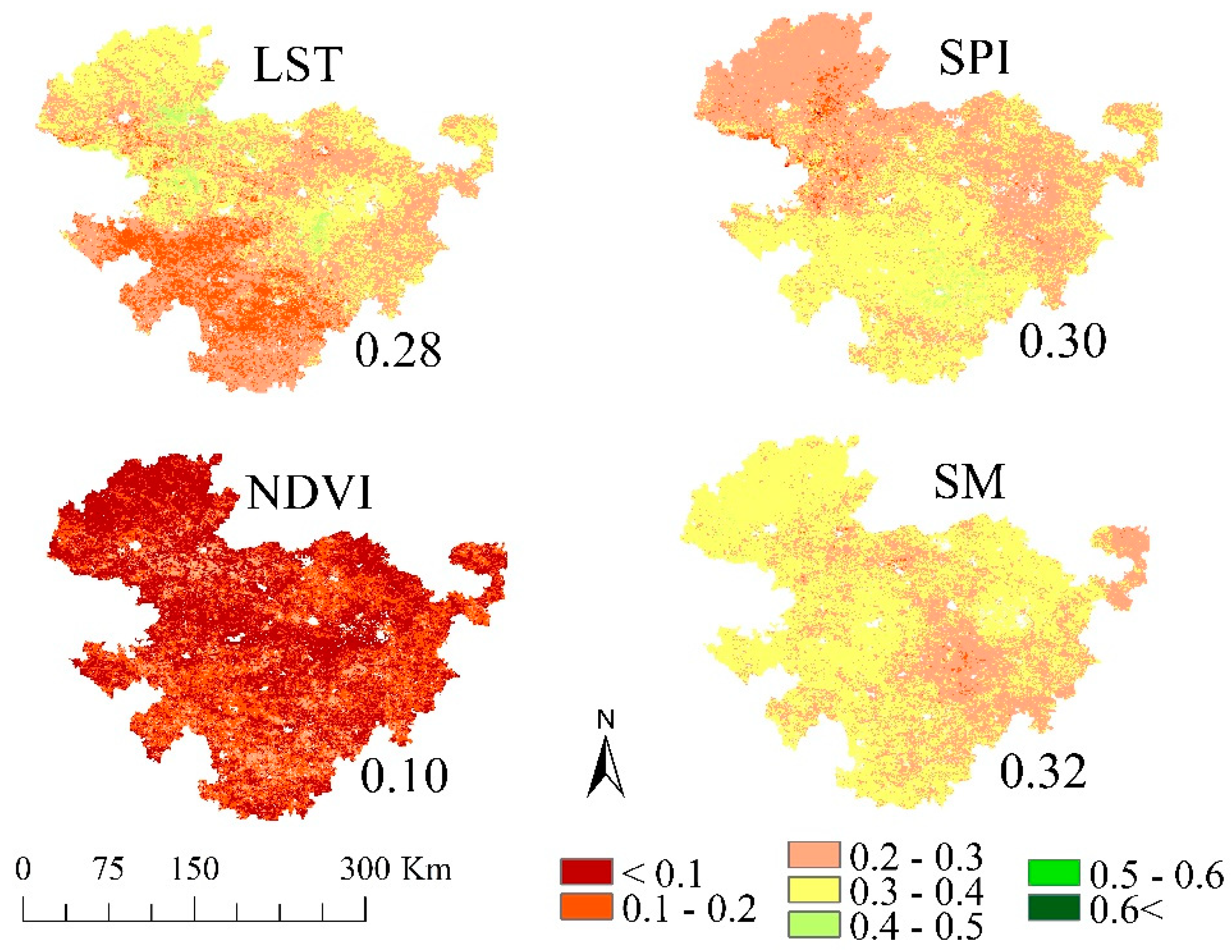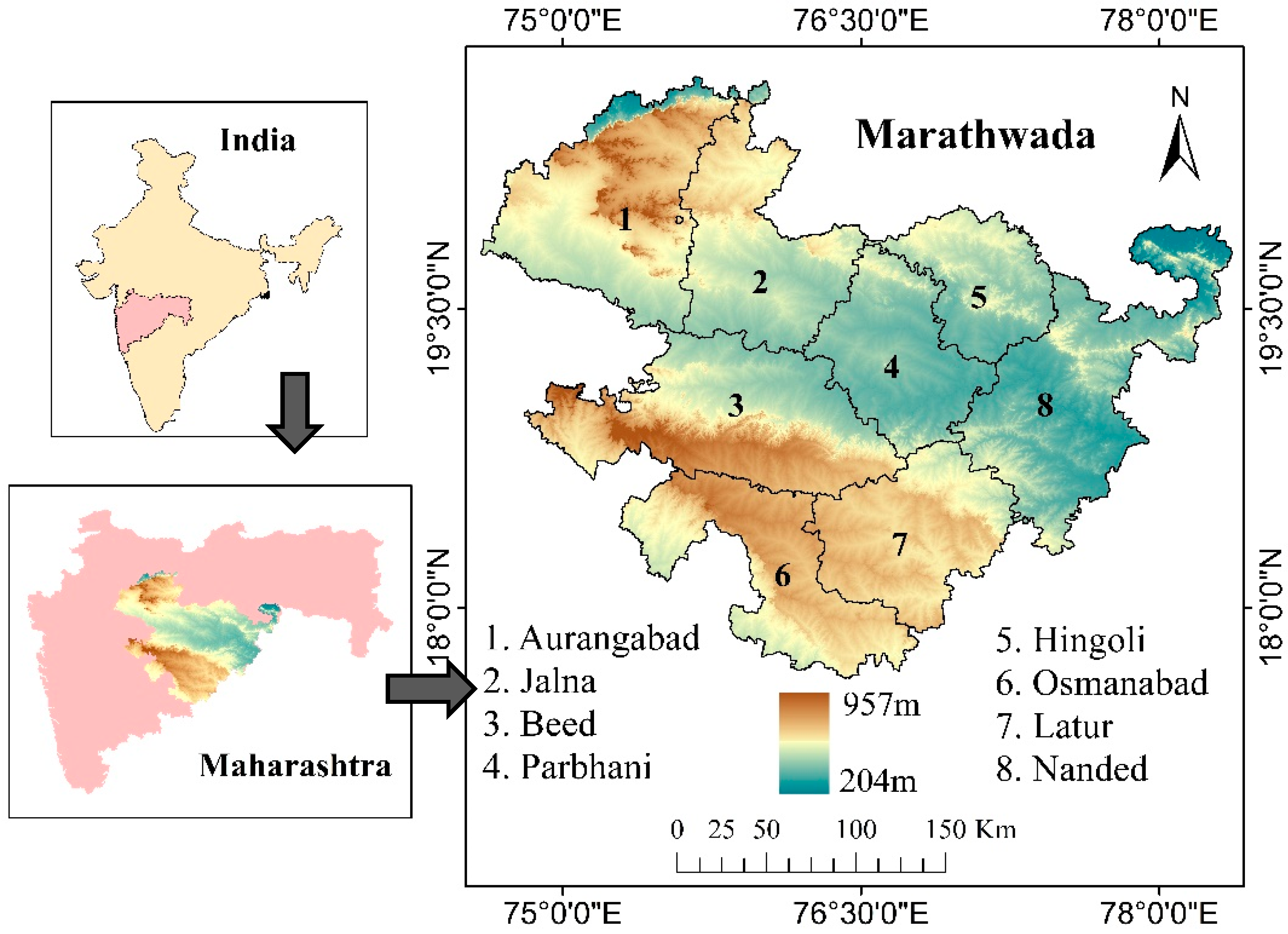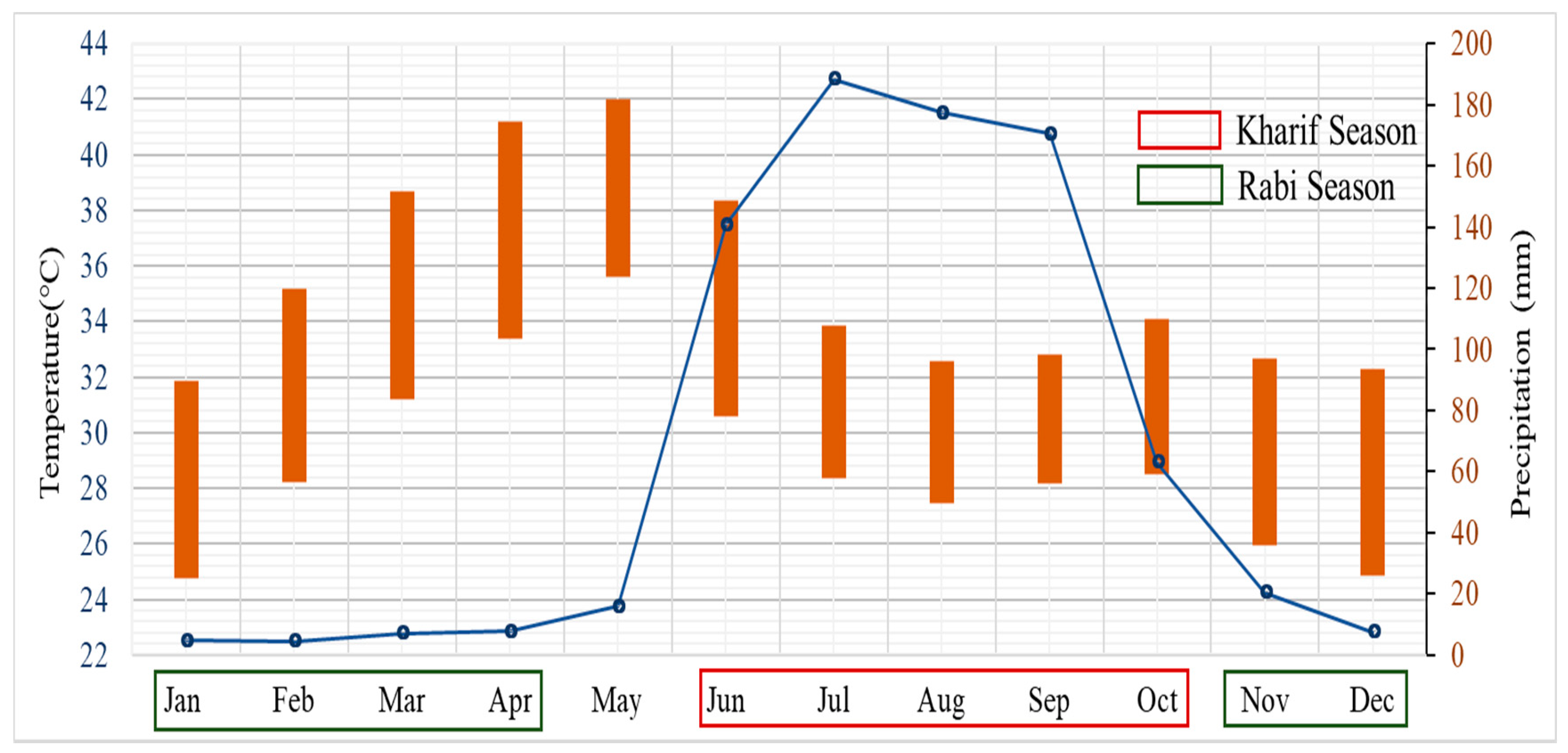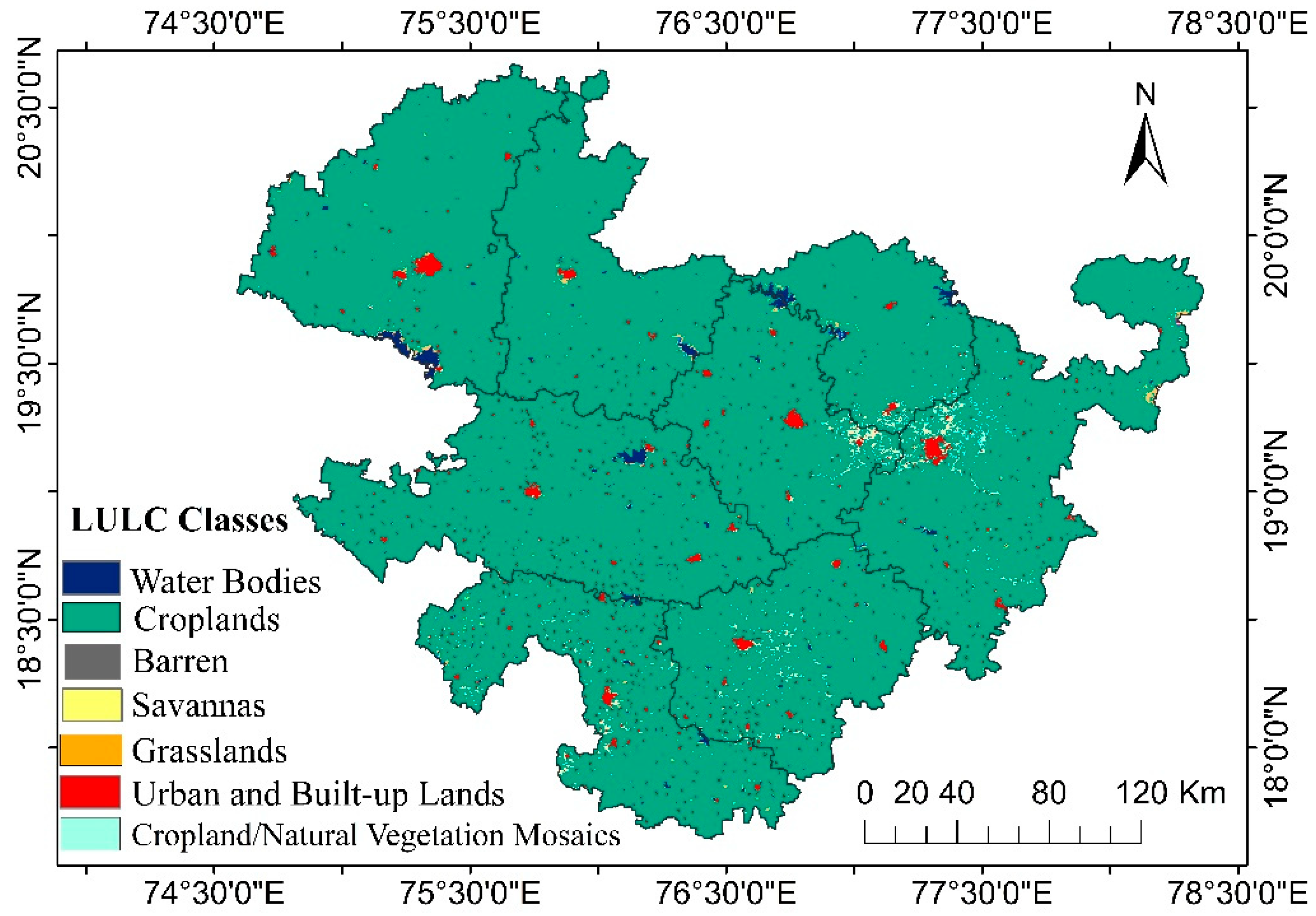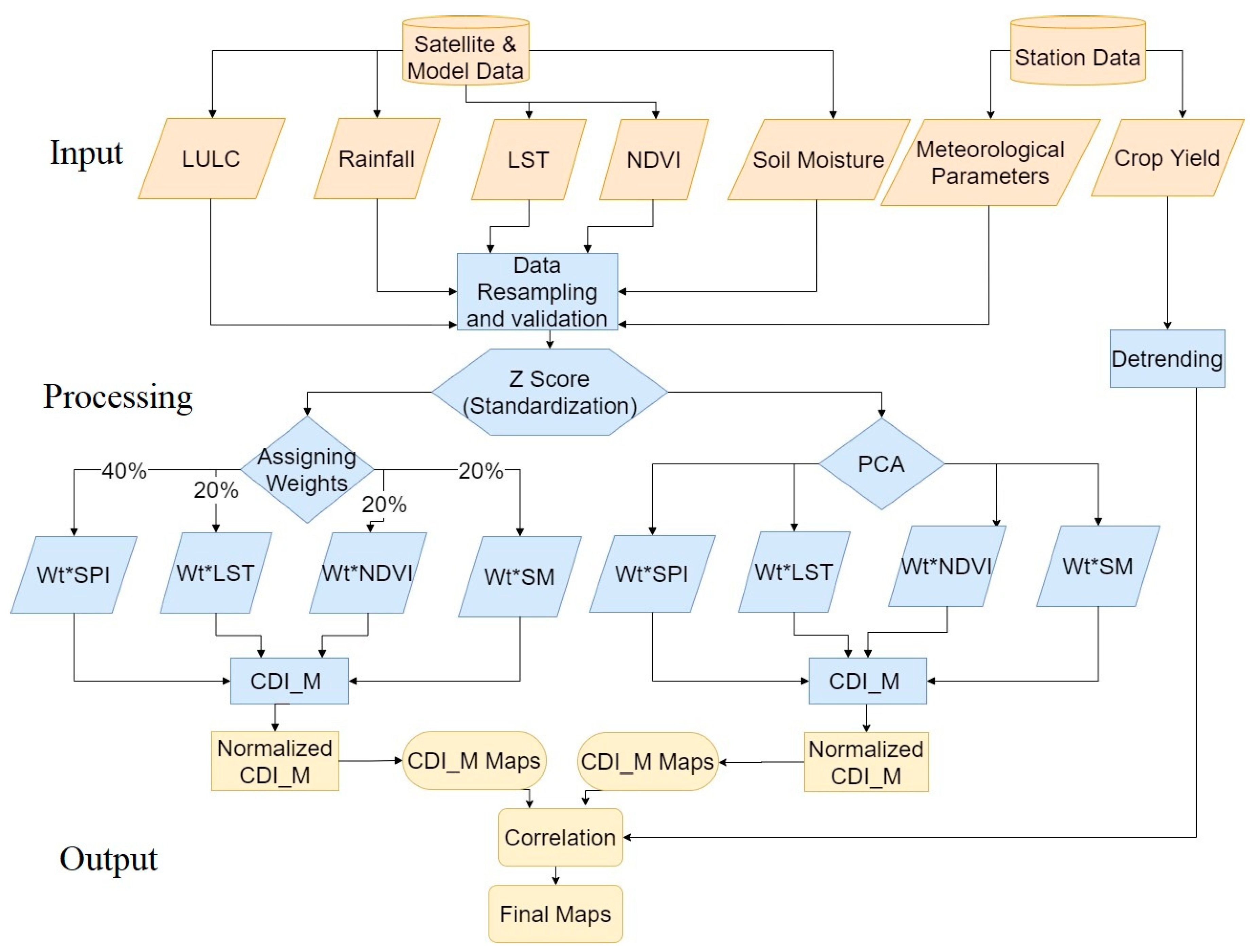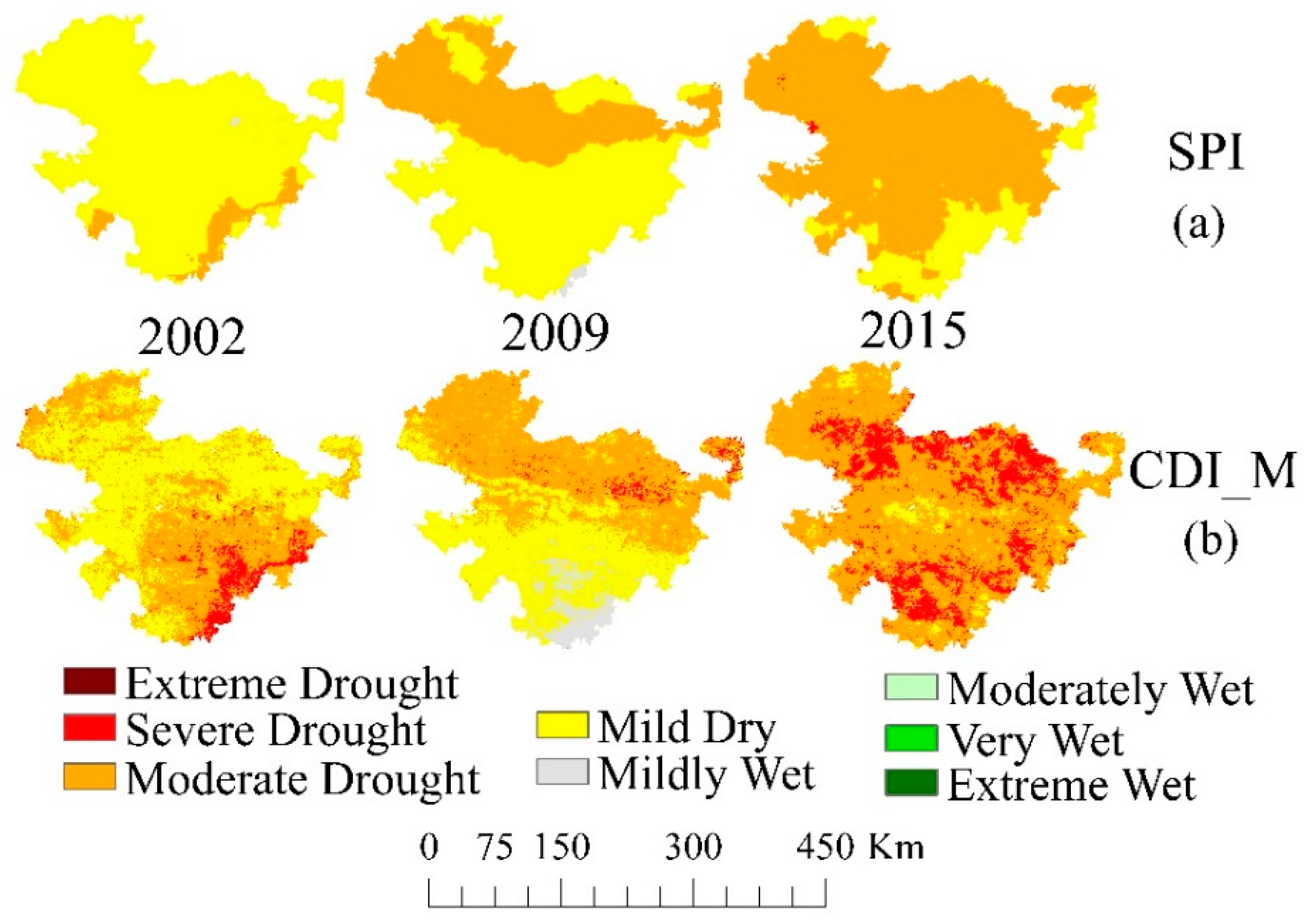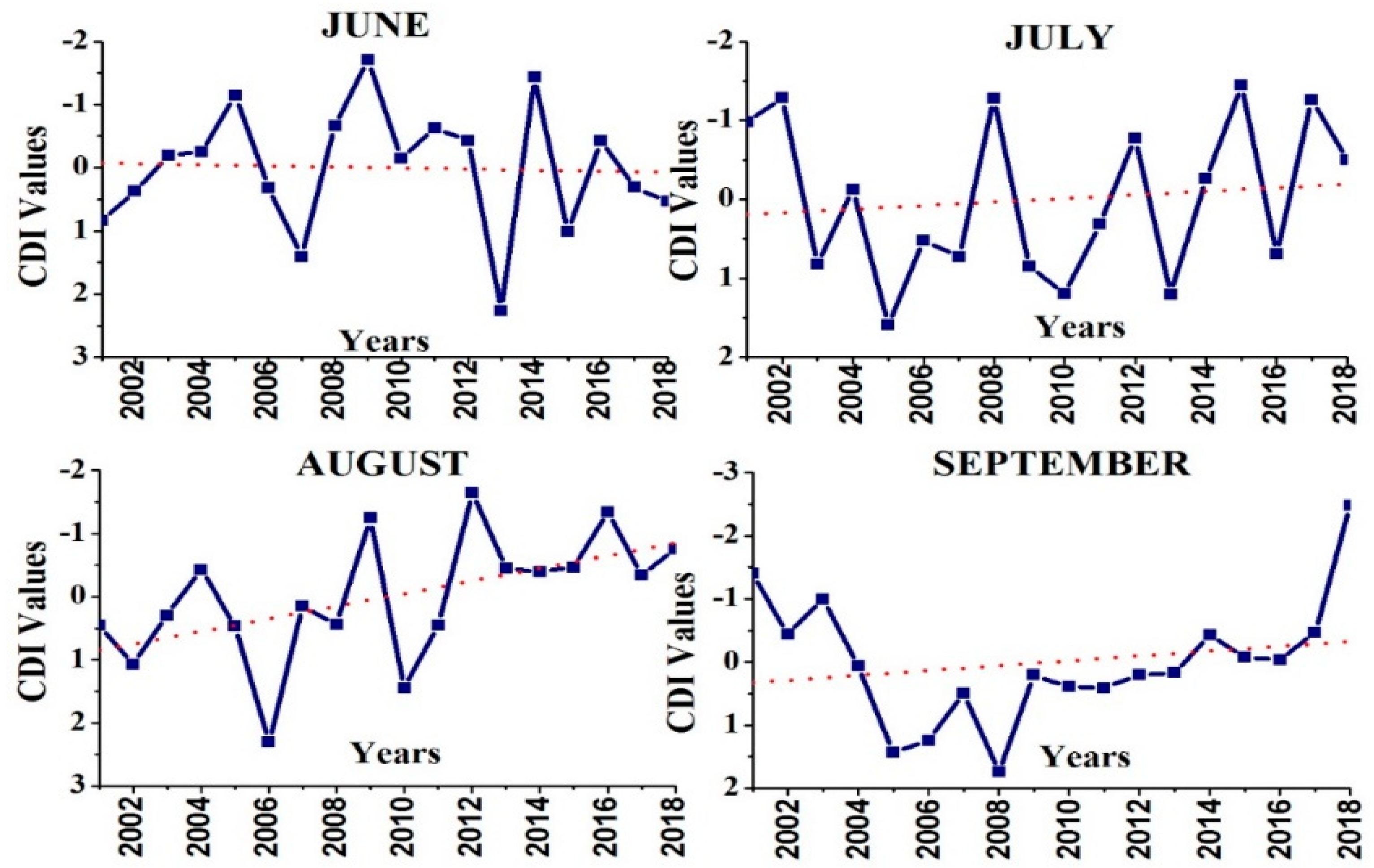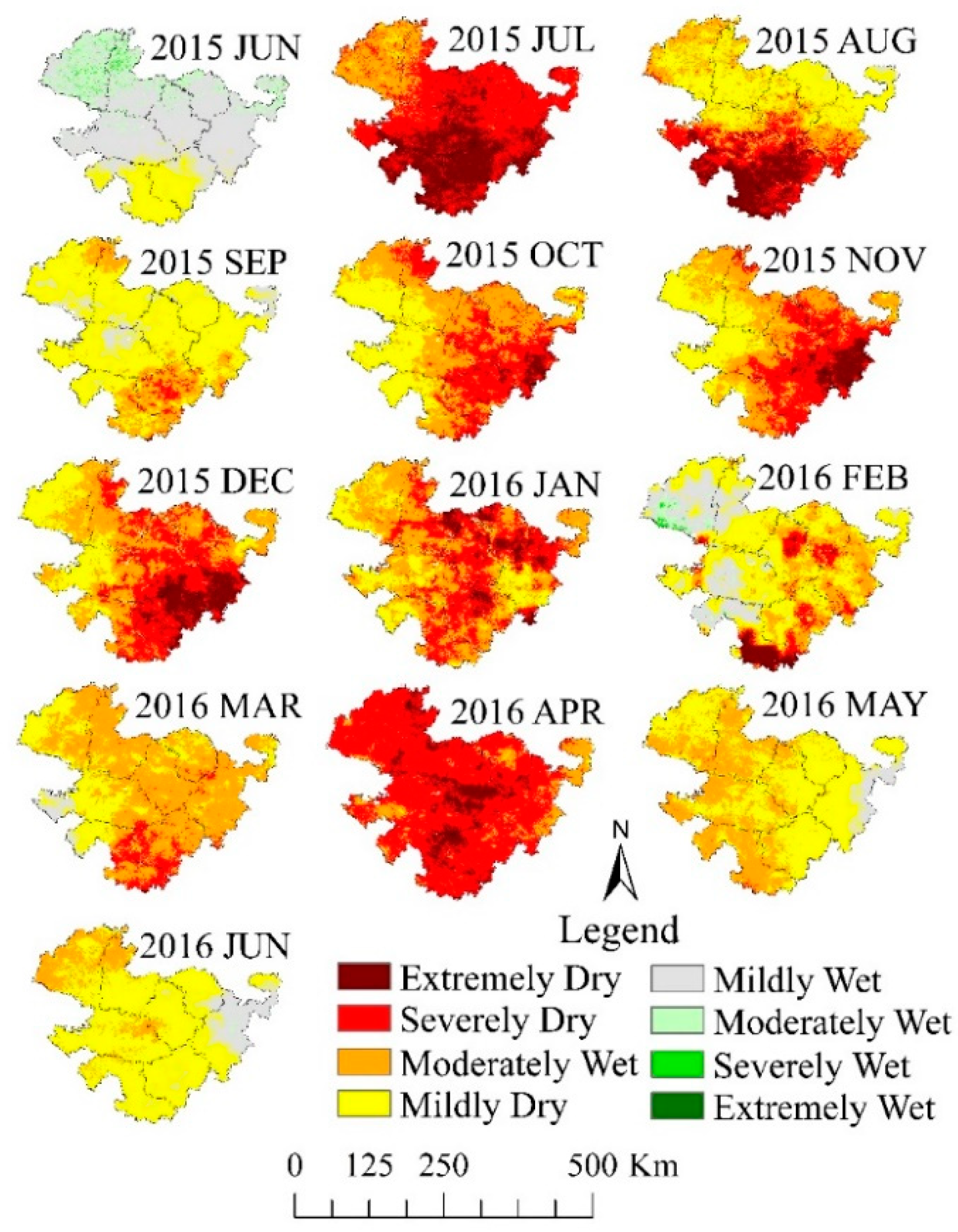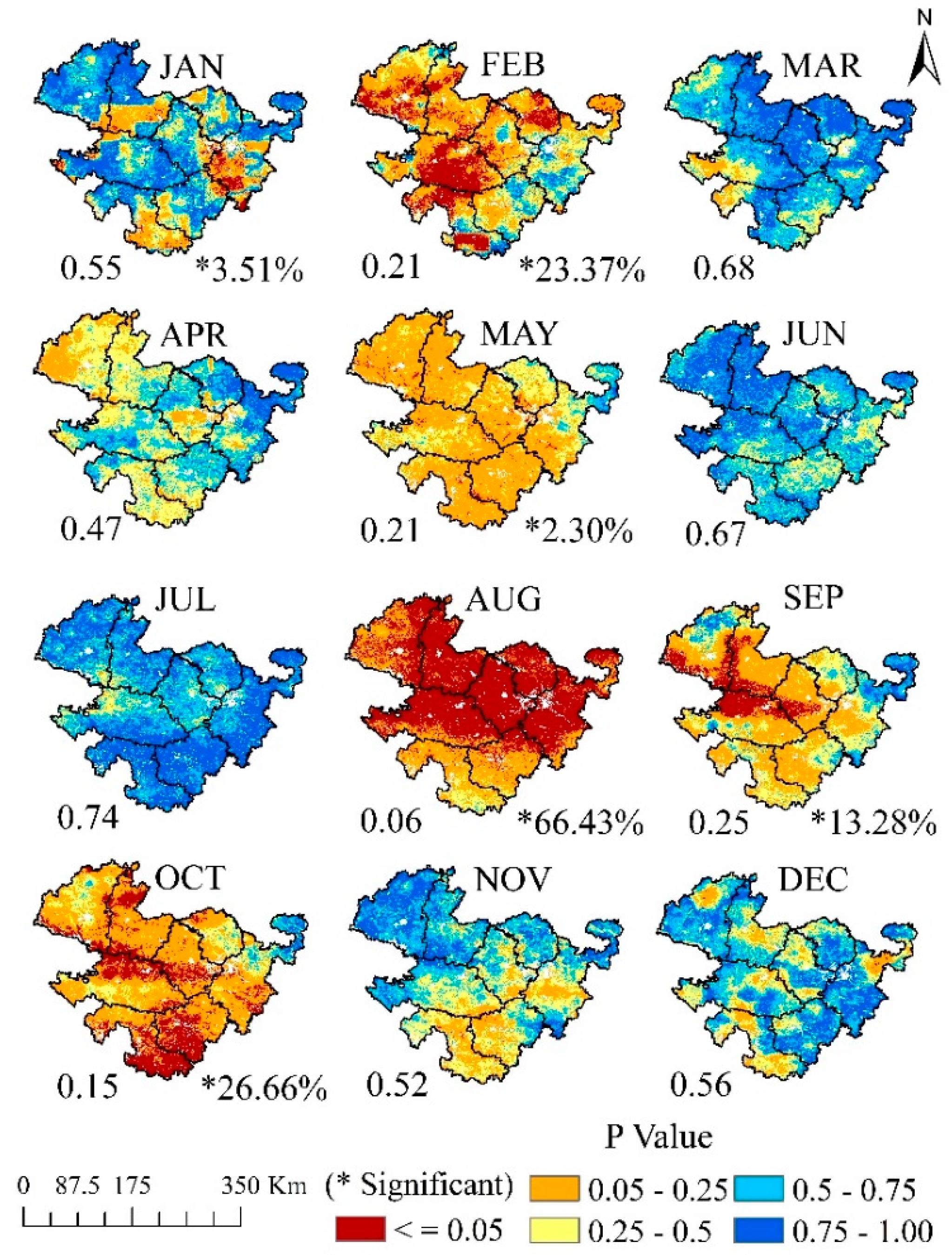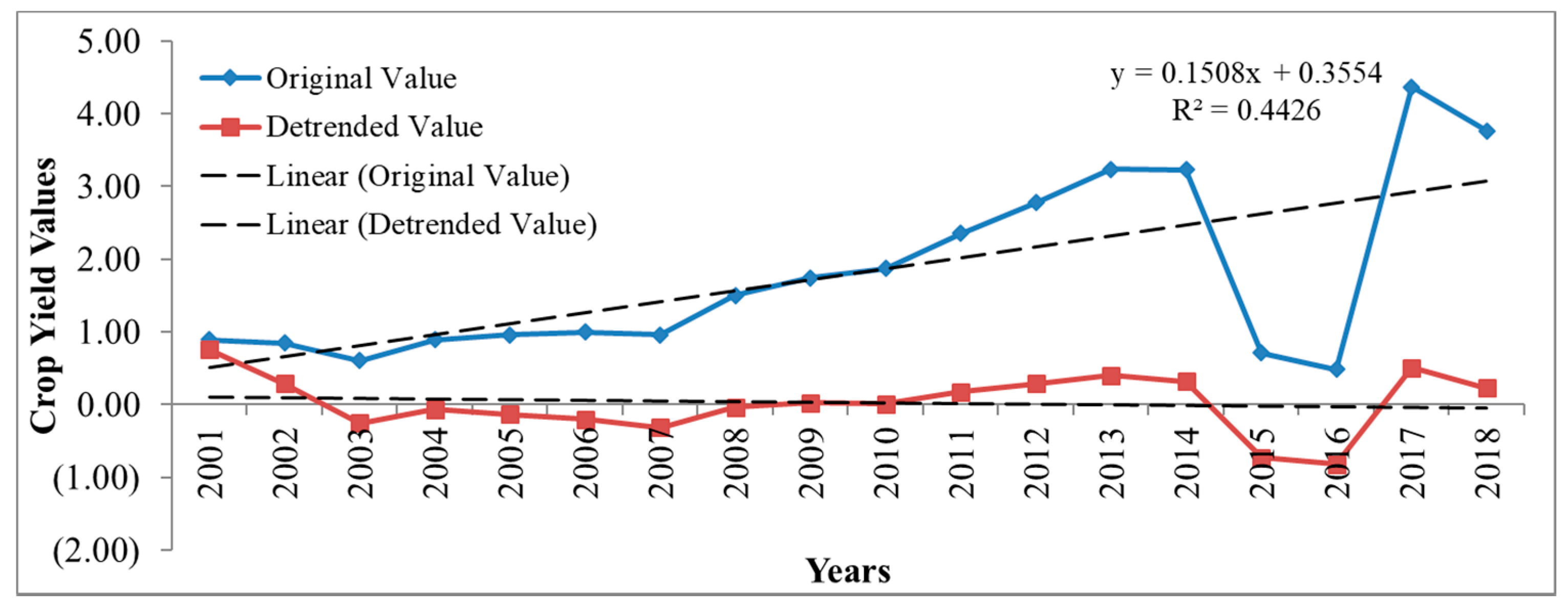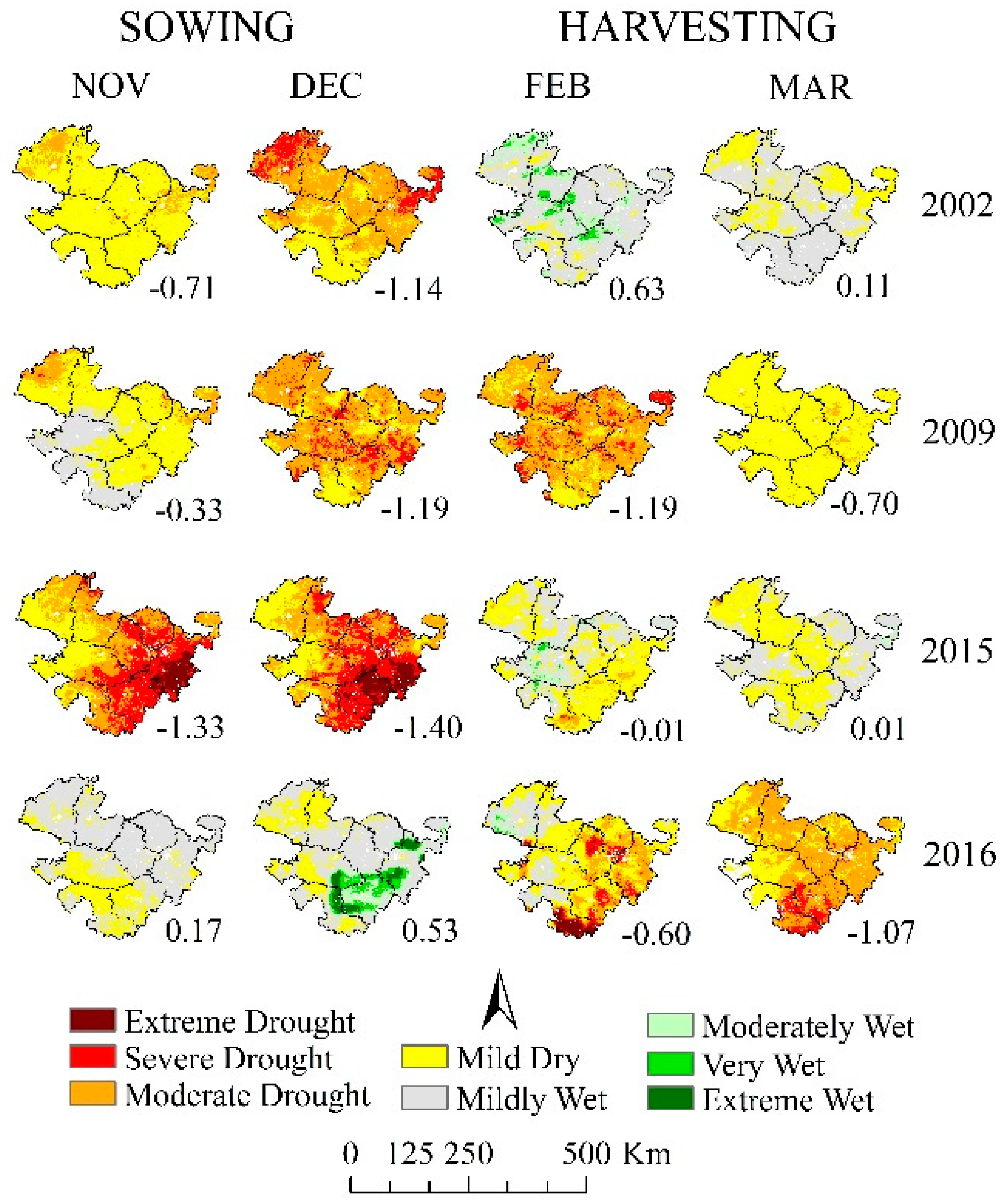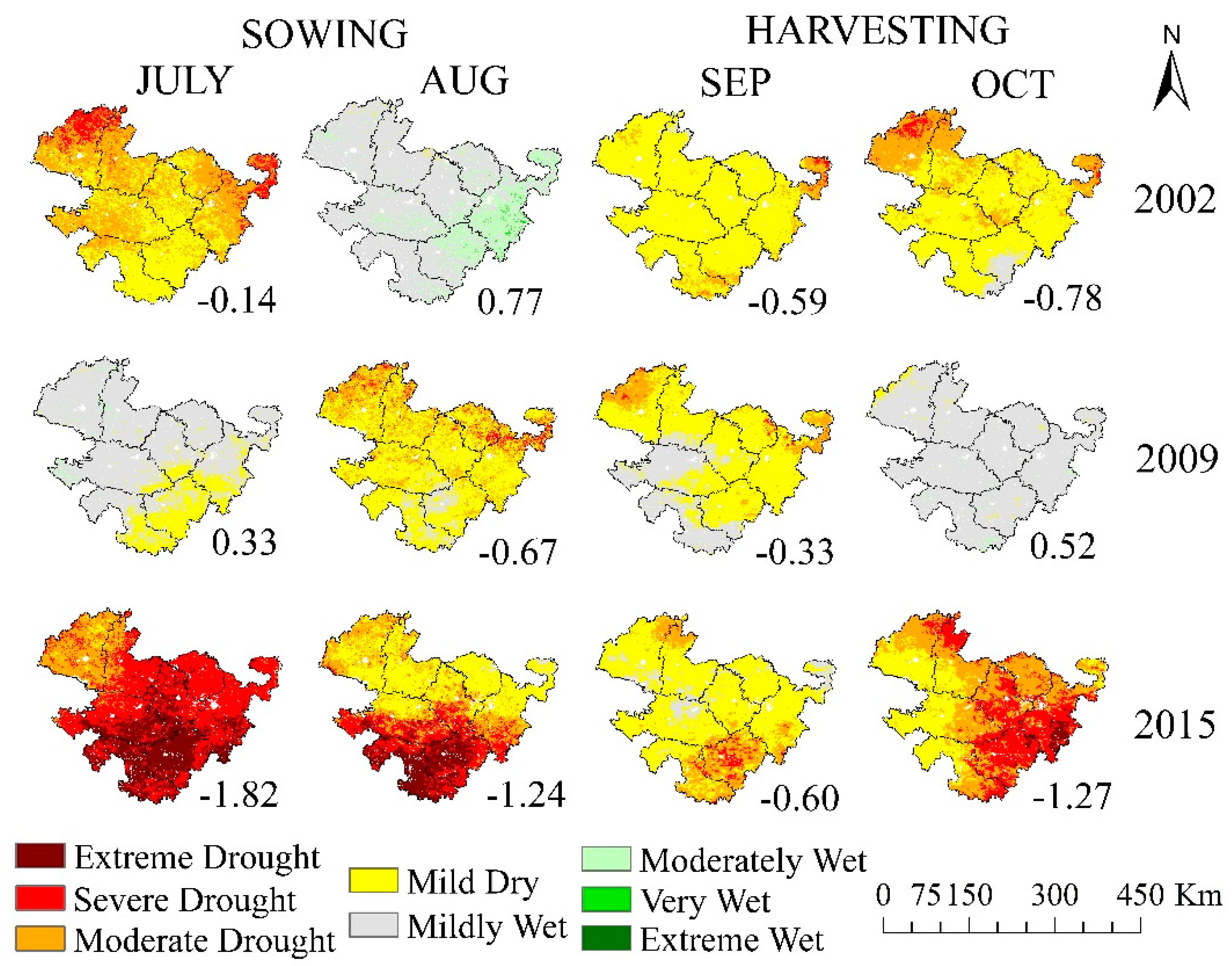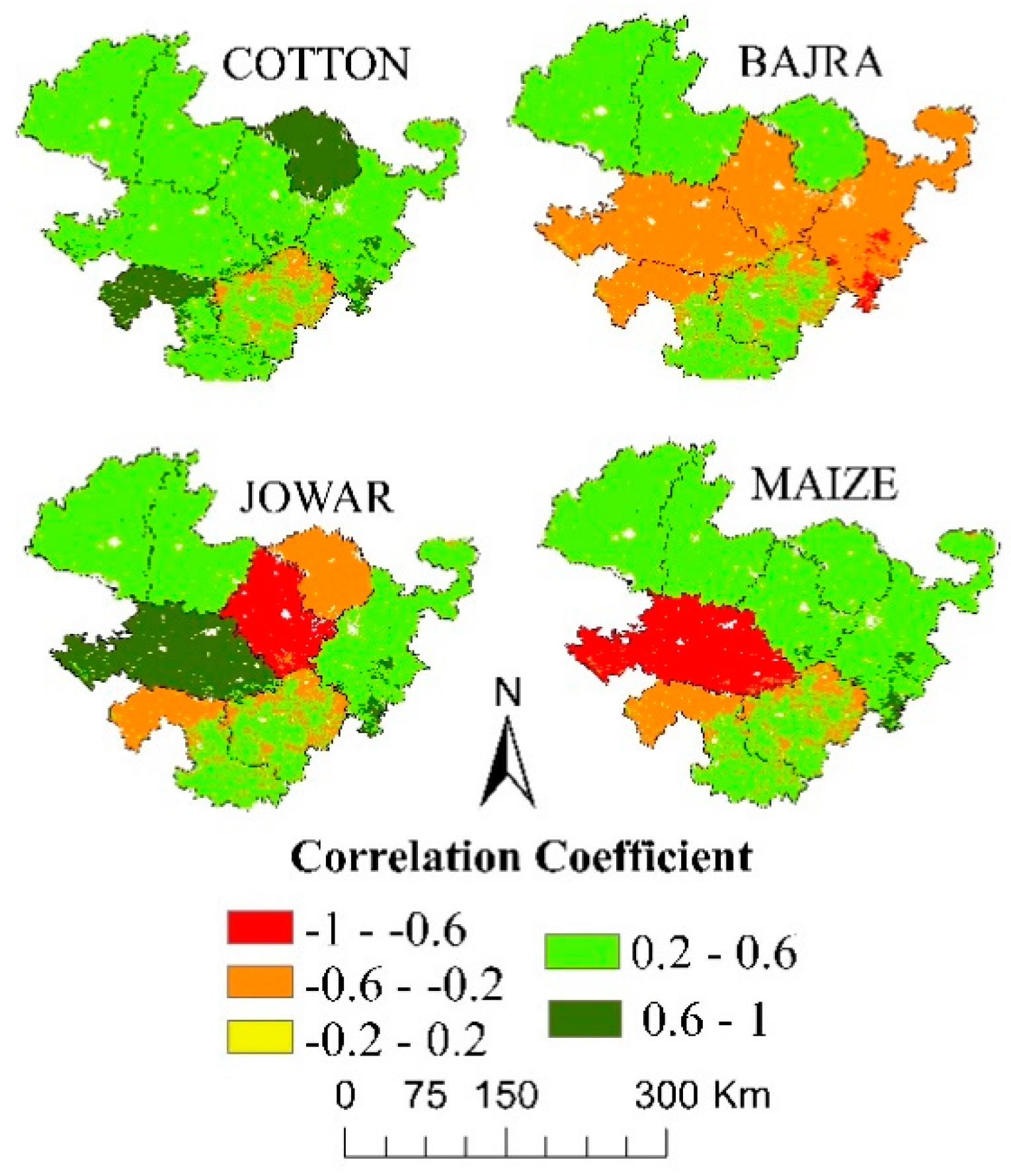1. Introduction
Droughts are one of the most devastating natural hazards over the globe, affecting millions of individuals in multiple ways (e.g., food security, economic losses, and migration). Megacities such as Delhi, Chennai, Karachi, Madrid, and Istanbul are already experiencing the extremely high risk of droughts, and many other regions could follow suit over the next few years [
1]. In the developing countries and food-insecure areas of Asia [
2] and Africa [
3], droughts have a profound impact on a nation’s economy and the everyday needs of people. Therefore, it is necessary to monitor and evaluate drought conditions with high accuracy, which will help decision-makers in the timely development of mitigation strategies [
4].
Drought is a complex phenomenon to assess because its definition varies by sector (e.g., agricultural versus hydrologic), and each event has its own unique set of characteristics. It can be described according to its spatio-temporal coverage, duration, and intensity [
5], and its severity can be determined by a number of factors, such as lack of rainfall [
6], groundwater depletion [
7], soil moisture deficiency [
8], or socioeconomic losses [
9]. In India, many researchers have studied droughts addressing these different parameters. In the 1980s, various drought studies were generally based on single drought variables that included rainfall and monsoon (June, July, August, and September) anomalies [
10,
11,
12]. More recently, Guhathakurta [
13], and Mahajan and Dodamani [
14] used the percent of normal precipitation (PNP) technique and identified the highest drought probability districts (>60%) for north India. The standardized precipitation index (SPI)-based research [
15,
16] marked the years 1972, 1987, 2002, 2009, and 2015 as severe-to-extreme drought years in India. Kripalani and Kulkarni [
17] and Kumar et al. [
18] experienced high episodes of severe droughts during El Niño events in comparison with normal and La-Niña activities over the Indian subcontinent, whereas Roxy et al. [
19] stated that the rising sea surface temperature of the Indian Ocean is responsible for the declining trend in the Indian summer-monsoon and increasing drought severities.
In recent years, remote sensing and high-resolution model data have played a vital role in drought assessment over India. SPI- and standardized precipitation evaporation index (SPEI)-based studies highlighted the Indo-Gangetic Plains as a high drought frequency region [
20], and research based on the temperature vegetation dryness index (TVDI), using MODIS products, studied changing levels of soil moisture in the Utter Pradesh [
21]. Bhuiyan et al. [
22] witnessed greater hydrological stress via the standardized water level index (SWI) when compared with the vegetation stress index (VCI) in the Aravalli terrain region of Rajasthan. The regional phenomenon of changing drought severities and its general shift towards south India, the Indo Gangetic Plains, and central Maharashtra was explained by Mallya et al. [
23]. In the semi-arid regions of India, drought has become more frequent [
24]. The first decade of the 2000s (2001–2010) was recorded as the warmest decade for India, and ocean–atmospheric systems are projected to result in a higher frequency of droughts over the next 30 year period (2020–2050) [
25]. Hence, the development of highly accurate early warning systems and drought assessment techniques are of high priority for India as attention turns to a more proactive drought response.
From the food security and societal needs perspective, agro-meteorological types of droughts are probably one of the essential key aspects of the drought assessment. Impacts of droughts are usually first documented in the agricultural sector. The World Wildlife Fund (WWF) has also reported that 22% of most-consumed food grains (e.g., wheat) are cultivated in high to very high drought-prone regions [
1]. Countries like India, in which 62% of the population is reliant on the farming sector, and 16% of the contribution to the nation’s gross domestic product is from an agrarian industry [
26], illustrate how agro-climatological drought studies play a crucial role in informing the country’s drought monitoring needs. In India, various studies examined the trends in agricultural droughts with the aid of vegetation indices retrieved from remote sensing methods, which include NDVI, VCI, and vegetation temperature condition index (VTCI) [
27,
28,
29,
30,
31]. However, until recently, there were very few comprehensive drought studies carried out over India that combine different environmental parameters that influence agricultural drought intensities. Drought is a result of variations in multiple agro-climatological settings rather than just a single environmental variable. Hence, the integration of several relevant environmental parameters is needed for improved drought monitoring capabilities that can better inform agricultural practices [
28,
32].
In the United States, Wu and Wilhite [
33] derived an operational drought monitoring technique for crops like soybean and corn. They considered the crop-specific drought index (CSDI) and SPI for their analysis. In recent years, the vegetation drought response index (VegDRI) was established and implemented over the continental US [
32,
34], which has also been developed in Korea [
35]. Sepulcre-Canto et al. [
36] developed an integrated agricultural drought Index for Europe by considering the SPI, SM, and photosynthetically active radiation (fAPAR) as input variables. An expert judgment-based integrated drought index was developed for Morocco [
37]. During their research, SPI, LST, ET, and NDVI were utilized as contributing parameters to derive the new index. To support the humanitarian aid organizations, a weighted, dependent-combined drought indicator was also implemented over Ethiopia [
38].
In Indian scenarios, Patel and Yadav [
28] integrated the modified rainfall anomaly index (MRAI) and the VCI to understand crop loss and its association with droughts over the Bundelkhand region. Zhang et al. [
39] developed a concurrent drought analysis method for India. This technique considered the SPI, SSI, SRI, and VCI to observe the changes in wheat production over various parts of India. On a country scale, Shah and Mishra [
7] have executed the integrated drought monitoring approach and identified the highest severity drought years (1965, 1987, 2002, and 2015) over multiple river basins. Other researchers [
40,
41,
42] have also reported the potential usefulness of applying an integrated drought index technique in India. Marathwada is among the severely drought-affected parts of India, where more than 1500 farmers committed suicide during the recent, severe drought years of 2015–16 [
43]. Swain et al. [
44]; Kulkarni et al. [
16]; and Purandare [
45] have studied frequent droughts in Marathwada using rainfall as an input variable for analyzing a specific drought year. Still, most of these studies did not combine multiple agro-climatological factors. Over the last few decades, the Marathwada semi-arid region of India is experiencing more frequent and extreme drought events, which have unprecedented water scarcity and agricultural crises [
43]. The global drought monitoring studies have also projected increasing drought severities over India in the near future [
46]. These studies have marked the semi-arid regions of India as one of the major worldwide hot spots to experience the more frequent and severe droughts. Therefore, a thorough understanding of drought scenarios over the Indian semi-arid regions has a local as well as global importance.
Most of the drought monitoring studies in India and elsewhere are still lingering with the single input parameters and worked on the country or subcontinent level. But at a regional scale, limited efforts have been taken; even though region-specific studies are crucial for developing policies and drought mitigation strategies. Many researchers have never implemented grid-based weight assignment methods to combine different input variables for a better assessment of droughts. Moreover, a single combining approach is widely used in previous studies, but limited endeavors have been made so far in testing two or more combining approaches at a time. Area-specific studies always have a crucial part in the policy management and designing the region-wise drought mitigation and adaptation plans, but most of the drought monitoring studies in India are still lagging. Therefore, the present study attempts to overcome the above-mentioned gaps in the current operational drought monitoring methods of India.
In this study, four primary drought indicator parameters (i.e., LST, SPI, NDVI, and SM) that are representing mainly the agricultural-field conditions (SM and NDVI), meteorological (SPI), and land atmospheric interaction (LST) were used to develop the combined drought index for Marathwada (CDI_M). Two approaches were also tested to combine these input parameters: (1) an expert judgment method (fixed weights, based on in-situ relationships and expert knowledge) and (2) a statistical (PCA) method. For the first time in India, the PCA technique is implemented through this study for the region-specific development of CDI. Previously, this approach was used by Hazaymeh and Hassan [
47] and Bayissa et al. [
48] over Jordan and Ethiopia, respectively. Implementing both the subjective (fixed weights) and objective (PCA) approaches and the comparative analysis of droughts results from these methods in this study stand as a unique contribution to the CDI-based drought assessment research. Hence, this newly developed CDI_M can be used for a comprehensive analysis of droughts and to better understand the relationship between major crop yields and drought events over Marathwada, India.
2. Study Area
The Marathwada meteorological subdivision is situated in the central and southeastern parts of Maharashtra state, India. This region falls under the tropical semi-arid zone, which is recently known for its farmers’ distress and suicides in the severe drought years 2014–15 [
43]. Administratively, the Marathwada region is known as the ‘Aurangabad’ division of Maharashtra state, which consists of eight districts, named as Osmanabad, Jalna, Parbhani, Nanded, Aurangabad, Beed, Hingoli, and Latur. The geographical latitudinal expansion of Marathwada is 17°35′N to 20°41′N, and the longitudinal extent is 74°40′E to 78°16′E (
Figure 1). The entire administrative expanse of the Marathwada region is 64,590 sq. Km, which covers 21% of the overall spread of Maharashtra state. Physiologically, Marathwada is part of the Deccan plateau and is mostly covered with deep black cotton soil. This area consists of three main geographical regions based on its altitude variations. The northern and southern uplands of Marathwada are known as the Ajantha mountain ranges and Balaghat hills, whereas the central part contains the Godavari and Manjara river basins. Marathwada belongs to the rain shadow region of the Sahyadri mountain ranges, making this area vulnerable to rainfall variabilities.
The average normal rainfall in Marathwada is 826 mm, ranging from 700 mm to 850 mm among the districts. The majority of annual precipitation (80%) is reliant on the southwest monsoon rains, which occurs in June, July, August, and September (J, J, A, and S) [
49]. Depending on these monsoon rains, rainfed agriculture has become the dominant agricultural system in this region. Therefore, a failure of the southwest monsoon rains directly or indirectly leads to devastating drought scenarios and agrigrain crises in Marathwada. In this area, the highest temperature (45 °C) occurs in May, and the coldest temperature (11 °C) is observed in December (
Figure 2) [
49]. Kharif (sowing is at the starting of the monsoon) and Rabi (seeding is at the end of the rainy season) are two major cropping seasons in Marathwada. Cotton, jowar, bajra, wheat, maize, pulses, groundnut, and sugarcane are the main crops grown in this region. The total share of food grains is 52% to the gross cropped yield, followed by cotton, which contributes 38% in overall agricultural output [
50]. Among food grains, jowar accounts for 25 to 40% of the total yield in each district of Marathwada. The variations in rainfall and temperature follow the nonuniform relief features in this region. Approximately 70% expanse of the overall geographic area is in agricultural production, whereas only 3.55% Marathwada region is under natural vegetation [
50].
4. Results and Discussion
Monthly maps of the CDI_M in
Figure 5 show the spatio-temporal variations of drought frequencies over Marathwada. In the past 18 years (2001–2018), both of the CDI_M methods detected the years 2002, 2009, 2015, and 2016 as severe drought years, with conditions ranging from mild to extreme drought intensities across the cropping season. For the study area as a whole, the highest drought frequencies (number of extreme drought years) were observed during the monsoon (Jun, Jul, Aug, Sep) and postmonsoon (Oct and Nov) months. For the agriculture sector, in particular, these observed months are crucial for the overall cropping cycle of the Kharif season, whereas increasing drought frequencies over these months may also directly impact the following Rabi season’s sowing activities in Marathwada. Between the years 2001–2018, the eastern parts of Jalna and central Parbhani experienced maximum drought frequencies (3/4 extreme drought years) in June and October, whereas the Osmanabad district had the highest number of drought frequencies (4 extreme drought years) in August (
Figure 5). For most of the remaining months (
Figure A1), only one to three severe to extreme drought events occurred over various parts of the Marathwada during the past 18 years. In general, Parbhani, Beed, and parts of Hingoli witnessed a higher number of drought frequencies during the monsoon and postmonsoon season, which can also be marked as continuous drought-affected expanses within Marathwada (
Figure 5). Over any region, three to four occurrences of severe to extreme drought events in 18 years are of great concern in the face of future uncertainties. Therefore, a timely assessment of these dry spells is a basic need for the socio-economic and environmental well-being of Marathwada.
Figure 6 represents the spatial association between the CDI_M results from both methods. The greater correlation (0.71 < r < 1.00) in Method-I and Method-II was found in March (average = 0.92) and May (average = 0.88) over most of the study area. The lowest values (0.24 < r < 0.55) of relationship were found in the Nanded, Aurangabad, and Parbhani districts in January (average = 0.71), and April (average = 0.78). In this study, Method-I is based on fixed assigned weights for calculating the CDI_M, where the highest weight (40%) was given to the rainfall parameter. For most of the months (
Figure A2), the correlation between both of the methods was low when Method-II (PCA) has assigned lower weights to rainfall in calculating the CDI_M (e.g., in January, Method-I allotted a 40% weightage to SPI, whereas the PCA method considered only a 9% contribution from SPI). Months with comparatively similar weight in both of the methods for all input parameters (or higher weight to rainfall in the PCA-based method) illustrates a greater correlation in CDI_M results between Method-I and Method-II (
Figure A2).
4.1. CDI_M-Based Spatio-Temporal Drought Analysis—Method-I
This method of computing the CDI_M is based on predefined weights for all of the input parameters, where the meteorological parameter (SPI) has the highest weight (40%), and equal weights (20% each) were assigned to all the other input variables (LST, SM, and NDVI). The time series of CDI_M was computed to evaluate the spatio-temporal variations in droughts over Marathwada. This method highlighted the years of 2002, 2009, and 2015–2016 as severe drought years, whereas other years were marked with wet or low-intensity dry spells. In the exceedingly affected dry periods of 2002 (53%), 2009 (42%), and 2015 (82%), nearly 40 to 60% of the study area was under severe-to-extreme stress of droughts (
Table 4). The central and southern districts of Marathwada (Beed, Latur, and Osmanabad) depicted a consistently high magnitude of dryness over the severe drought years. The influence of long-term and extreme droughts often extend over adjacent years. Therefore, several months during 2003, 2008, 2014, and 2016 also experienced mild to moderate dry stress as an extension of extreme drought years (2002, 2009, and 2015). This method observes that, with SPI, the remaining three input parameters are also collectively responsible for the enhancement of drought severities.
Figure 7 shows the spatial coverage of significant drought years over Marathwada, derived from individual SPI method (
Figure 7a) of drought analysis and based on CDI_M (
Figure 7b). The individual SPI technique was able to identify the drought conditions at some extent, but CDI_M gives the more detailed and precise nature of expanses of drought (
Figure 7).
In the CDI_M computation, Method-I assigned a 40% weight to the SPI, and in Marathwada, 80% of the annual rainfall comes from monsoon rains. Hence, compared to other months, this drought assessment method is highly accurate for the monsoon season. The trends in CDI_M values over the monsoon months in Marathwada are graphically represented in
Figure 8. This figure exhibits the increasing trend in CDI_M values during July, August, and September. The CDI_M values range from −2 to +2. Lower values of CDI_M (negative) indicate the drier nature of a surface. Therefore, upward trends in the CDI_M inferred the increasing drought intensities from 2001 to 2018 in Marathwada. The enhanced drought stress is more pronounced in August and July, which are the primary sowing months for the Kharif crops. Other than monsoon months, an increasing trend in CDI_M values was also noticed during February, April, and October within the study area.
4.2. CDI_M-Based Spatio-Temporal Drought Analysis—Method-II
In this method, the PCA technique is used to integrate all the input parameters for the development of the CDI_M. The PCA-based method takes care of monthly variations in input variables and their changing percentage contribution with respect to space and time. Hence, the PCA-based CDI_M method seems to be more effective for drought monitoring over Marathwada. In this method, the first PC value is considered to assign the specific weight for each input parameter (SPI, SM, NDVI, and LST).
Table 5 indicates parameter wise average weights for every month over Marathwada, whereas
Figure A3 represents the sample of the spatial distribution of contribution of each input parameter in June. It is noted that on an annual scale, and in both the crop harvesting seasons (Rabi and Kharif), soil moisture is the highest contributing (35%) parameter in the CDI_M followed by LST (25%), SPI (21%), and NDVI (18%). The spatial distribution maps of weights for the Rabi season (harvesting months) show the highest weight values for SM and NDVI, and the lowest values are for the SPI and LST, at the central part of Aurangabad, Beed, and Jalna district. During the Kharif season (harvesting months), in the extreme southern portion of Osmanabad district, SM is given the maximum weighting followed by eastern and central Aurangabad for SPI and LST.
The time series of CDI_M maps from this method have highlighted the monsoon and postmonsoon months of 2015 and the premonsoon season of 2016 as the most severe drought period over Marathwada during our study’s period of record. These two years and in particular the months of July, August, October, and April were noted as one of the most life-threatening droughts of the 21st century [
43]. In July 2015 and October 2016, nearly 92% of the Marathwada region experienced severe-to-extreme drought conditions, and the average CDI_M values for most of the districts were less than −1.92. This severity of the drought continued for almost eleven months, starting from 2015 July to mid-June 2016 (
Figure 9). During this period, the average spatial drought spread has varied from 30% to 95% with respect to each month. In general, the south, southeastern, and central region of the Marathwada, which covers a major part of the Osmanabad, Beed, Latur, and Parbhani districts, was frequently under rigorous dry spells (
Figure 9). Higher elevation and less availability of surface water resources are the common characteristics for almost all of the regions mentioned above. These characteristics might have acted as additional parameters for the enhancement of drought severities and the reduction in agricultural productivity over the 2015–16 period.
Like Method-I, this method also depicted 2002 and 2009 as drought years, but compared to the first method, the PCA-based technique showed higher variations in month wise spatial distribution of droughts over Marathwada.
Figure 10 represents the monthly spatial spread of statistical significance (P values) of the CDI_M values with respect to years. In August, 66.4% of Marathwada noticed a significantly increasing trend (p ≤ 0.05, hence, accepted the alternative hypothesis, i.e., drought intensities are increasing with respect to time) in CDI_M intensities, followed by October (26.7% area, where p ≤ 0.05), February (23.4% area, where p ≤ 0.05), and September (13.3% area, where p ≤ 0.05) (
Figure 10). CDI_M values range from −2 to +2; therefore, the increasing trend means CDI_M values are shifting towards more negative values, overtime for the period 2001 to 2018. In all of the above-identified months, parts of Hingoli, Parbhani, and Beed districts have experienced a significant upwelling trend in CDI_M values, whereas Aurangabad and Osmanabad districts noticed it in August and October, respectively (
Figure 10). The results of spatio-temporal trends in the CDI_M emphasizes the necessity of a PCA-based drought assessment method for the region and month specific drought management strategies.
4.3. CDI_M and Its Relation with Crop Yield
Numerous studies have observed the significant negative effect of severe to extreme drought events on crop yields over the USA [
66], Canada [
66], China [
67], Korea [
68], Bangladesh [
69], and other parts on the world. India has particularly shown the highest risk of reduction in maize crops under the drought years [
66]. Intense dry spells in India always have a dire influence on the community and environment. Marathwada agriculture sector, in particular, bears 80% of the direct impacts of severe drought events. Therefore, in the present research, we have tried to comprehend the spatio-temporal association between major crop yields and cropping season drought incidences. To reduce the influence of other non-agro-climatological parameters on crop production, all the crop yield datasets were detrended, as shown in
Figure 11. Further, these detrended crop yield values were compared with the monthly CDI_M intensities using the statistical correlation method. CDI_M values from both the CDI_M computation methods and for all the wet and dry years were compared to the detrended anomalies of crop yields; however, in the drought years, the outcomes from the PCA-based CDI_M method showed a greater correlation (r > 6.5). Hence, the relationship between the CDI_M from Method-II (PCA-based) and crop yield anomalies is discussed below.
4.3.1. Rabi Season
Figure 12 represents the spatio-temporal patterns of dry spells in the highly-affected drought years for Marathwada. In the Rabi season, most of the sowing and harvesting months experience mild to extreme drought conditions over the years 2002, 2009, and 2015–16. For the sowing months, in particular, the Nanded, Parbhani, and Hingoli districts have noticed the highest intensity dry spells. During the harvesting months, perhaps due to some local factors such as irrigation, only a few small areas of extremely dry pockets (Osmanabad, Parbhani) and equal distribution of mild wet and mild dry spells were detected over most regions of Marathwada.
Figure 13 demonstrates a spatial distribution of correlation coefficient values among major crop yields and CDI_M drought intensities over the harvesting of the Rabi season. This figure has identified the eastern and southeastern districts of Marathwada with higher correlation values (r > 0.5), whereas parts of Beed, Aurangabad, and Osmanabad in the west had negative correlations. In the case of jowar and wheat crop, a significant relationship was marked over large portions of Hingoli (r = 0.82 over 78% area), Parbhani (r = 0.76 over 58%), and Nanded (r > 0.6 over 32% area) districts. For a detailed understanding of the temporal association between crop yield and CDI_M values, linear regression graphs were plotted, and regression equations were generated over randomly selected sites.
In a further step, two potential assumptions (i.e., CDI_M values may increase or decrease by 0.5 or 1) were made for the future CDI_M, and based on it, the future changes in crop yield were predicted [
70]. Regression equations given in
Table 6 suggest that in the future, if the values of CDI_M increases or decreases by 0.5, then crop yields for Wheat, Jowar, and Maize will rise or decline by 16.7%, 9.2%, 9.1%, respectively. If the CDI_M varies by + or ‒1, then the yield will alter by 33% (wheat), 18.4% (Jowar), and 18.2% (Maize) Tonnes/ Hectare.
4.3.2. Kharif Season
Monsoon rainfall is the primary resource for Kharif crops in Maharashtra. Hence, the fluctuations in the monsoon rains directly impact the dryness, soil moisture availability, and the overall crop productivity in the region.
Figure 14 shows the spatial distribution of dry spells in the highest drought-affected years (2002, 2009, 2015–16) over the sowing and harvesting months of Kharif. In 2002, eastern parts of Aurangabad and Nanded districts observed severe to extreme drought intensities during the starting of sowing and at the end of the harvesting season. 2015 was a crucial time over most of the cropping cycle, where more than 40% of the area of Marathwada continuously experienced extreme drought. In 2015, Kharif, Osmanabad, and Latur were the two most affected districts due to the life-threatening dry spells.
In the Rabi season, jowar and cotton crops had a stronger relationship (r > 0.5) with the CDI_M based drought intensities. At the district level, in particular, almost the entire area of Beed and some pockets of the Nanded showed a significant association (r > 0.7) in CDI_M and yield of jowar (
Figure 15). In the case of cotton, the entire Hingoli and northern horn of Osmanabad districts observed a significant correlation (r > 0.7) between crop yield and drought intensities (
Figure 15).
To get the general idea of future Kharif crop yield anomalies, based on assumed variations in the CDI_M values (increase or decrease by 0.5 or 1), the same regression equation technique was implemented as described for the Rabi crop. Regression equations given in
Table 7 suggest that in the future, if the values of CDI_M increase or decrease by 0.5, then crop yields for Jowar and Cotton will rise or decline by 19.8%, and 11.3%, respectively. If the CDI_M varies by + or −1, then the yield will alter by 39.5 % (Jowar) and 22.6% (Cotton) Tonnes/Hectare.
4.4. Limitations and Future Recommendations
In this study, a weighted combination of input parameters was used to compute the CDI_M. The weights for CDI_M were based on expert judgment (Method-I) and the principle component analysis (PCA) weighting approach (Method-II). However, several other methods like entropy [
71,
72], Copula [
73] can also be implemented and compared in the development of combined drought indicators.
All the input parameters used for this study were initially available in different spatial resolutions. Some of the datasets were best available only with the coarse resolution (SM and LST—0.25°). Though these coarse resolution data still represented the spatial variability, this study recommends the use of high-resolution input data for future research.
The correlation coefficient maps of the crop yield with the CDI_M showed a weak correlation (r < 5.0) over some parts of the study area. Unavailability of grid-based or high-resolution crop yield data and shorter data length (18 years) can be responsible for the above-mentioned poor association between crop yield and CDI_M.
Current operational drought monitoring methods in the Marathwada, India, are based on a single input parameter, i.e., rainfall. Hence, the combined drought indicator developed in this study constitutes a new technique for agricultural drought monitoring over the study area. The drought assessment methods used in the framework of this study recommend its implementation over the various parts of the world by adopting the region-specific input variables and their relative weights.

